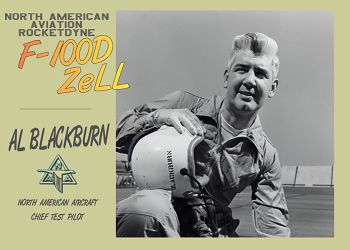
 |
Blackburn strapped himself into the cockpit and prepared for launch. The airplane was loaded to a gross weight of 40,064 pounds with one 275-gallon fuel tank on one wing and a T-63 simulated nuclear weapon on the other.
With a cloud of black smoke and orange flame, the NF-100D surged into the sky. At booster burnout, the airplane was traveling at a speed of 250 knots and had reached an altitude of 250 feet. Blackburn waited to feel the XM-34 drop away, but it remained stubbornly attached to the aircraft. This was a real problem for Blackburn. The booster was now a 2,600-pound deadweight, and it extended below the landing gear. There was no way for the pilot to execute a safe landing.
Blackburn flew the NF-100D out over Harper Dry Lake, and tried to shake the booster loose. For nearly an hour, he struggled without success. Finally, having no other option, Blackburn ejected. He had always anticipated that if something went wrong, it would occur during the launch sequence. Hence, he had selected a small, fast-opening parachute. This meant that his descent was fairly rapid and Blackburn sustained some back injuries when he landed on the dry lakebed.
The NF-100D was completely destroyed when it struck the desert. A lengthy investigation revealed that the left-hand booster attachment bolt failed to shear and no inflight maneuver could dislodge it, as the minimum shear value of 35,000 pounds was considerably higher than any loads that could be applied by the pilot's control inputs.
The next NF-100D was equipped with a redesigned booster attachment system featuring explosive bolts that could be detonated on command. After that, there were no more problems. Between March and October of 1958, there were 14 successful launches.
